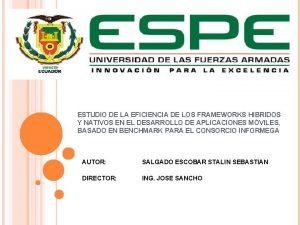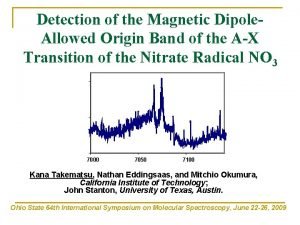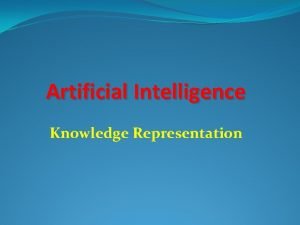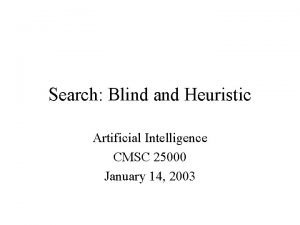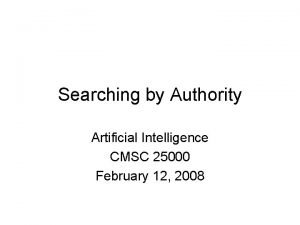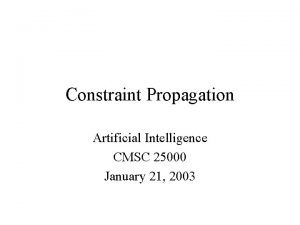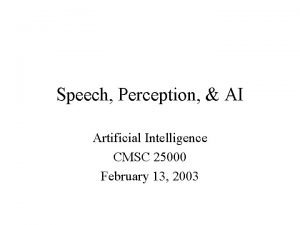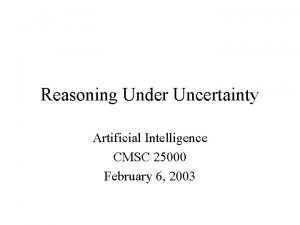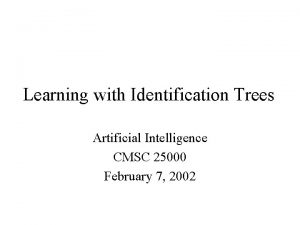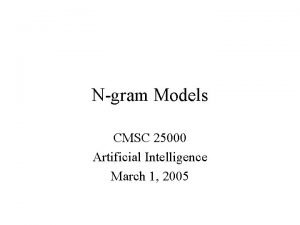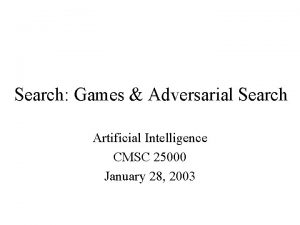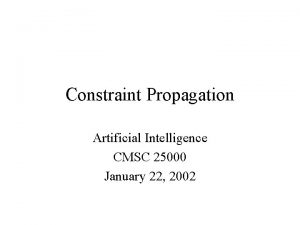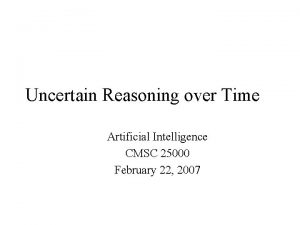Rules Knowledge Representation Manipulation Artificial Intelligence CMSC 25000



















- Slides: 19

Rules: Knowledge Representation & Manipulation Artificial Intelligence CMSC 25000 January 8, 2002

Agenda • Knowledge Representation: – Assertions & Rules • Knowledge Manipulation: – Forward & Backward Chaining – Deduction & Reaction Systems • Costs, Choices, and Mechanisms

Representing Knowledge • Assertion: – Statement that something is true • “Stretch is a giraffe”, ”The sky is blue” – Collection of assertions: “Working Memory”

Representing Knowledge: Rules • If - then rules If A 1, A 2 Then B 1, B 2 Antecedent Consequent

Representing Knowledge: Rules • May include variables, e. g. If (parent-of ? x ? y), (parent-of ? y ? z), then (grandparent-of ? x ? z) • Variables: ? x, ? y, ? z – Same name => same value

Knowledge Manipulation • Forward chaining: – Reason from “if” antecedents to “then” consequents • Backward chaining: – Confirm hypothesis matching “then” patterns by verifying “if” patterns

Rule-based Systems • Separate knowledge from control – Contrast from typical programming: Integrated Add consequent Assertions Rule Interpreter Select rule Match antecedent Rules

Forward Chaining • Identify triggered rules – Antecedents match assertions – Match variables -> rule instances • Select a triggered rule to fire – Conflict resolution strategy: first, random, LRU, combination • Fire a rule – Add consequents to list of assertions (deduction) – Perform action(s) in consequent (reaction)

Forward Chaining Example R 1: if (signs (nasal congestion)) R 4: if (temp >100) (signs (viremia)) then (signs (fever)) then (diagnosis influenza) R 5: if (headache) R 2: if (runny nose) then (signs (achiness)) then (signs (nasal congestion)) R 6: if (signs (fever)) R 3: if (body-aches) (signs (achiness)) then (signs (achiness)) (cough) Assertions: then (signs (viremia)) F 1: runny nose Execution: F 2: temp = 101. 5 R 2 Fires: Asserts (signs (nasal congestion)) F 3: headache R 4 Fires: Asserts (signs (fever)) R 5 Fires: Asserts (signs (achiness)) R 6 Fires: Asserts (signs (viremia)) R 1 Fires: Asserts (diagnosis influenza)

Forward Chaining with variables IF (parent ? x ? y) (parent ? y ? z) THEN (grand-parent ? x ? z) (parent A A B C B) C) D) E) (parent ? x ? y) (parent ? y ? z) (grand-parent ? x ? z) (x: A y: B) (y: A z: C) (y: B z: D) (y: C z: E) conflict (x: A y: B conflict in y z: D) in y (x: A y: C) (y: A z: B) (y: A z: C) (y: B z: D) (y: C z: E) conflict (x: A y: C in y z: E) (x: B y: D) (y: A (y: B (y: C z: B) z: C) z: D) z: E) conflict in in y y (x: C y: E) (y: A (y: B (y: C z: B) z: C) z: D) z: E) conflict in in y y

Forward Chaining: Analysis • Reason from antecedents to consequents – Trigger rules if all antecedents match assertions – Add assertions or do actions in consequents • May be computationally expensive – Many possible deductions to make – Brute force approach: k antecedents, N assertions • N^k!! – Rete method

Backward Chaining • Test hypothesis – Reason from consequents to antecedents – Use assertions and rules – If no assertions or rules give evidence, ask questions

Backchain(G) - Rule interpreter If G matched assertion in database, then return True Else If there are rules whose consequent matches G For each matching rule R For each antecedent C of R If Backchain(C) is true, proceed Else go to next rule. Return True /* when all antecedents are true */ Return False /* when no matching rule succeeds */ Else, ask user if G is true. If answer is “yes” return True, Else return False. From Lozano-Perez, April 00

Backward Chaining Example R 1: if (signs (nasal congestion)) (signs (viremia)) then (diagnosis influenza) R 2: if (runny nose) then (signs (nasal congestion)) R 3: if (body-aches) then (signs (achiness)) R 4: if (temp >100) then (signs (fever)) R 5: if (headache) then (signs (achiness)) R 6: if (signs (fever)) (signs (achiness)) (cough) then (signs (viremia))

Backward Chaining Example Hypothesis: (diagnosis influenza) Diagnosis Influenza AND (Signs (nasal congestion)) (Signs (viremia) AND (Runny nose) (Signs (fever)) (Signs (achiness))(cough) Ask OR Yes (Temp > 100) Ask Yes (Body-ache) (Headache) Ask No Yes

Reaction Systems • Deduction systems – Produce new assertions – Keep firing all triggered rules • Order less important • Reaction systems – Produce arbitrary actions: assertions, printing, moving, bagging – Side effects -> Order important

Reaction System: Example • For example, IF (at ? x ? y) (move ? x to ? z) ADD (at ? x ? z) DELETE (move ? x to ? z) (at ? x ? y) • Assume an initial database: – (at A room 1) (move A room 2) • Then the rule would add: (at A room 2) • And, delete: – (at A room 1) (move A room 2)

Conflict Resolution • • • When >1 rule is triggered, which fires? ? First: Rules are ordered. Fire first triggered. Random: Randomly select a rule to fire Most specific: Fire rule with most antecedents Least recently fired: Avoids rule starvation. – Combination • Design rule set wrt conflict resolution strategy

Conflict Resolution: Deduction • Generally, less important, but • Possible to create infinitely recursive rule – if ? x, (not ? x))…. • Need conflict resolution – Allow other rules to fire • E. g. stop rule
 Knowledge manipulation in artificial intelligence
Knowledge manipulation in artificial intelligence What is declarative knowledge in ai
What is declarative knowledge in ai 61000-25000
61000-25000 Ejemplos de sarcodinos
Ejemplos de sarcodinos Iso 25000
Iso 25000 750000/25000
750000/25000 750000/25000
750000/25000 25000-7000
25000-7000 Mycin expert system
Mycin expert system What is state space search in ai
What is state space search in ai Searching for solutions in artificial intelligence
Searching for solutions in artificial intelligence 15-780 graduate artificial intelligence
15-780 graduate artificial intelligence American association for artificial intelligence 17 mar
American association for artificial intelligence 17 mar Kecerdasan kepemimpinan
Kecerdasan kepemimpinan Artificial intelligence assessment
Artificial intelligence assessment What math is used in artificial intelligence
What math is used in artificial intelligence Peas in ai examples
Peas in ai examples 15-780 graduate artificial intelligence
15-780 graduate artificial intelligence Xkcd deep learning
Xkcd deep learning Fuzzy propositions in ai
Fuzzy propositions in ai




